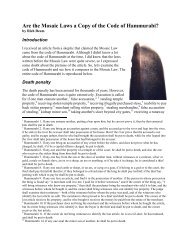Coming to Grips with the Early Church Fathers - Evidence for God ...
Coming to Grips with the Early Church Fathers - Evidence for God ...
Coming to Grips with the Early Church Fathers - Evidence for God ...
Create successful ePaper yourself
Turn your PDF publications into a flip-book with our unique Google optimized e-Paper software.
<strong>Coming</strong> <strong>to</strong> <strong>Grips</strong> <strong>with</strong> <strong>the</strong> <strong>Early</strong> <strong>Church</strong> Fa<strong>the</strong>rs’ Perspective on Genesis John Millam<br />
Having read much of <strong>the</strong> original writings <strong>for</strong> myself, I was surprised at how differently <strong>the</strong><br />
church fa<strong>the</strong>rs interpreted <strong>the</strong> Old Testament compared <strong>to</strong> how most people would understand it<br />
<strong>to</strong>day. Some of <strong>the</strong> fa<strong>the</strong>rs’ conclusions seem illogical or even bizarre by modern standards.<br />
Robert Bradshaw recognized this as well. In his study of <strong>the</strong> early church, Bradshaw provides an<br />
important discussion of early church hermeneutics and how it differs from <strong>to</strong>day. 23 Though<br />
Bradshaw views this subject from a young-earth perspective, he takes a well-balanced approach<br />
<strong>to</strong> <strong>the</strong> <strong>to</strong>pic of early church hermeneutics. (I’ll provide only a limited summary here. See<br />
Bradshaw’s work <strong>for</strong> additional in<strong>for</strong>mation.)<br />
The key reason <strong>the</strong> church fa<strong>the</strong>rs often interpreted Scripture differently than we do <strong>to</strong>day is<br />
because <strong>the</strong>y saw <strong>the</strong> Old Testament as being primarily Chris<strong>to</strong>logical. According <strong>to</strong> Gerald<br />
Bray, “Christians generally believed that <strong>the</strong> Old Testament spoke about Jesus Christ, not merely<br />
prophetically but in types and allegories which <strong>the</strong> Spirit revealed <strong>to</strong> Christians.” 24 They<br />
employed typology and o<strong>the</strong>r nonliteral devices <strong>to</strong> allow <strong>the</strong>m <strong>to</strong> see Jesus in <strong>the</strong>se passages and,<br />
hence, connect Scripture <strong>to</strong> <strong>the</strong>ir current situation. The literal/his<strong>to</strong>rical meaning would<br />
correspondingly have been treated as secondary (not surprising since straight Jewish his<strong>to</strong>ry<br />
would have had little meaning <strong>to</strong> non-Jewish Christians.) All <strong>the</strong> church fa<strong>the</strong>rs interpreted in<br />
this fashion, albeit <strong>to</strong> different degrees.<br />
For example, Justin Martyr saw references <strong>to</strong> trees or wood in <strong>the</strong> Old Testament, e. g., <strong>the</strong> tree<br />
of life in Eden (Genesis 2:9), <strong>the</strong> Oak of Mamre (Genesis 13:18; 14:13), <strong>the</strong> staffs of Moses and<br />
Aaron, and <strong>the</strong> floating wood of Elisha (2 Kings 6:1-7) as prefiguring <strong>the</strong> cross of Christ. Origen<br />
added several more examples, such as <strong>the</strong> cedarwood that played a part in <strong>the</strong> ritual cleansing of<br />
lepers (Leviticus 14:1-7) and <strong>the</strong> wood that made <strong>the</strong> bitter water sweet (Exodus 15:22-27) <strong>to</strong><br />
this list and o<strong>the</strong>r church fa<strong>the</strong>rs provided still more. So, it seems that almost any piece of wood<br />
mentioned in <strong>the</strong> Old Testament could be viewed as prefiguring <strong>the</strong> cross of Jesus. Water,<br />
particularly Noah’s flood, was likewise seen as prefiguring baptism.<br />
Numerological association was ano<strong>the</strong>r commonly used <strong>to</strong>ol in interpretation. A simple example<br />
is <strong>the</strong> popular notion of <strong>the</strong> “eighth day.” 25 Given that creation occurred in seven “days,” <strong>the</strong><br />
eighth was taken as symbolizing <strong>the</strong> new creation. This idea was established when <strong>the</strong> fa<strong>the</strong>rs<br />
saw parallels <strong>to</strong> Jesus Christ being raised on <strong>the</strong> eighth day (i. e., <strong>the</strong> first day of <strong>the</strong> second<br />
week) and even babies being circumcised on <strong>the</strong> eighth day (Genesis 17:12). Even more<br />
important, <strong>the</strong> church fa<strong>the</strong>rs viewed <strong>the</strong> eighth day as marking <strong>the</strong> beginning of <strong>the</strong> new creation<br />
after seven “days” of one thousand years each. (This escha<strong>to</strong>logical idea was also based on<br />
numerical association—see below.)<br />
In some cases, numerological arguments were taken <strong>to</strong> <strong>the</strong> extreme. For example, in <strong>the</strong><br />
apocryphal Epistle of Barnabas, Abraham’s 318 servants (Genesis 14:14) are interpreted as<br />
23. Robert I. Bradshaw, Creationism and <strong>the</strong> <strong>Early</strong> <strong>Church</strong>, last updated January 25, 1999,<br />
http://www.robibrad.demon.co.uk/Contents.htm.<br />
24. Gerald Bray, Creeds, Councils and Christ (Downers Grove, IL: Inter-Varsity Press, 1984), 50.<br />
25. Ironically, part of <strong>the</strong> impetus <strong>for</strong> <strong>the</strong> “eighth day” is a misreading of <strong>the</strong> headers of Psalms 6 and 12. The<br />
Hebrew reads sheminith; <strong>the</strong> word’s meaning is uncertain but most modern translations understand it <strong>to</strong> be a<br />
musical term. The early church fa<strong>the</strong>rs, however, followed <strong>the</strong> Greek Septuagint and Latin Vulgate, which<br />
rendered it “on <strong>the</strong> eighth.”<br />
Page 8 <strong>Evidence</strong> <strong>for</strong> <strong>God</strong> from Science






